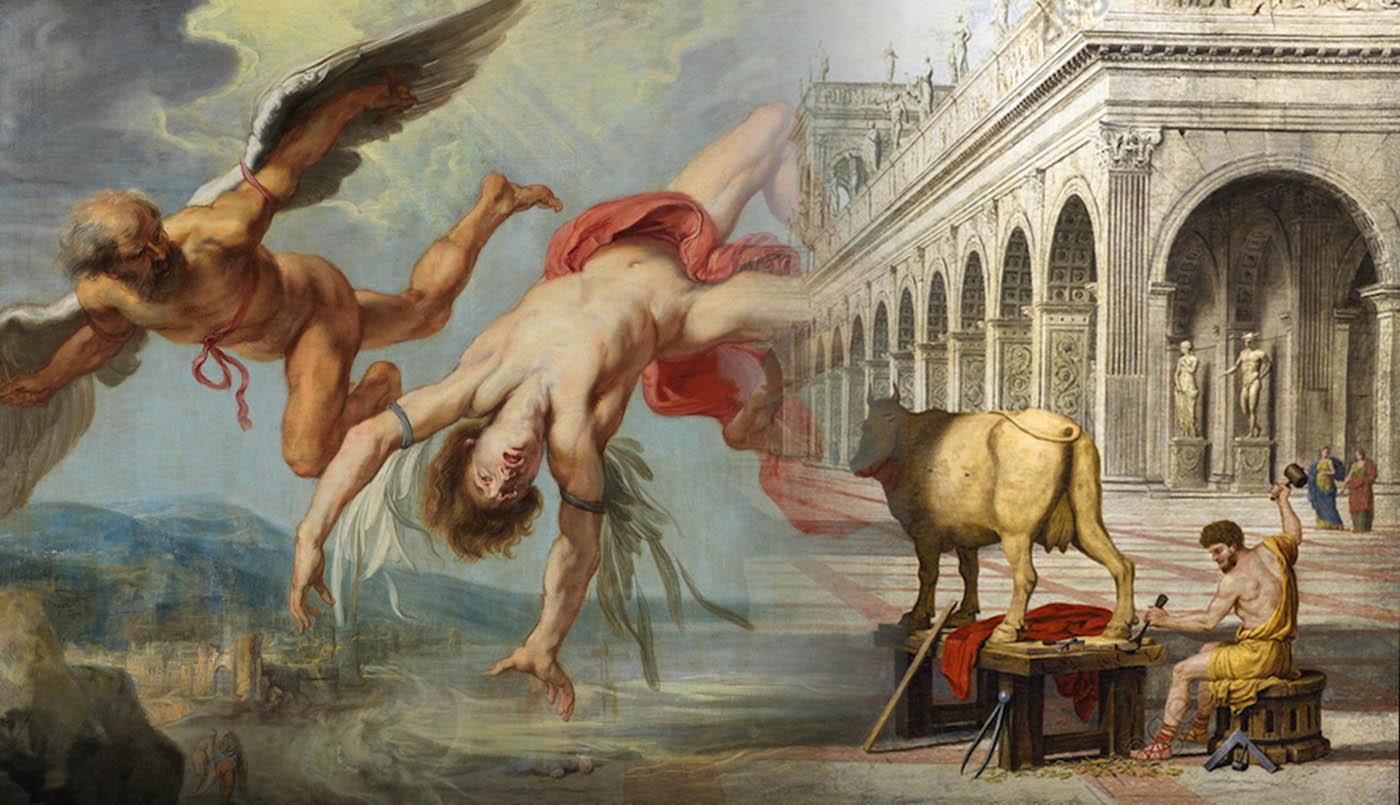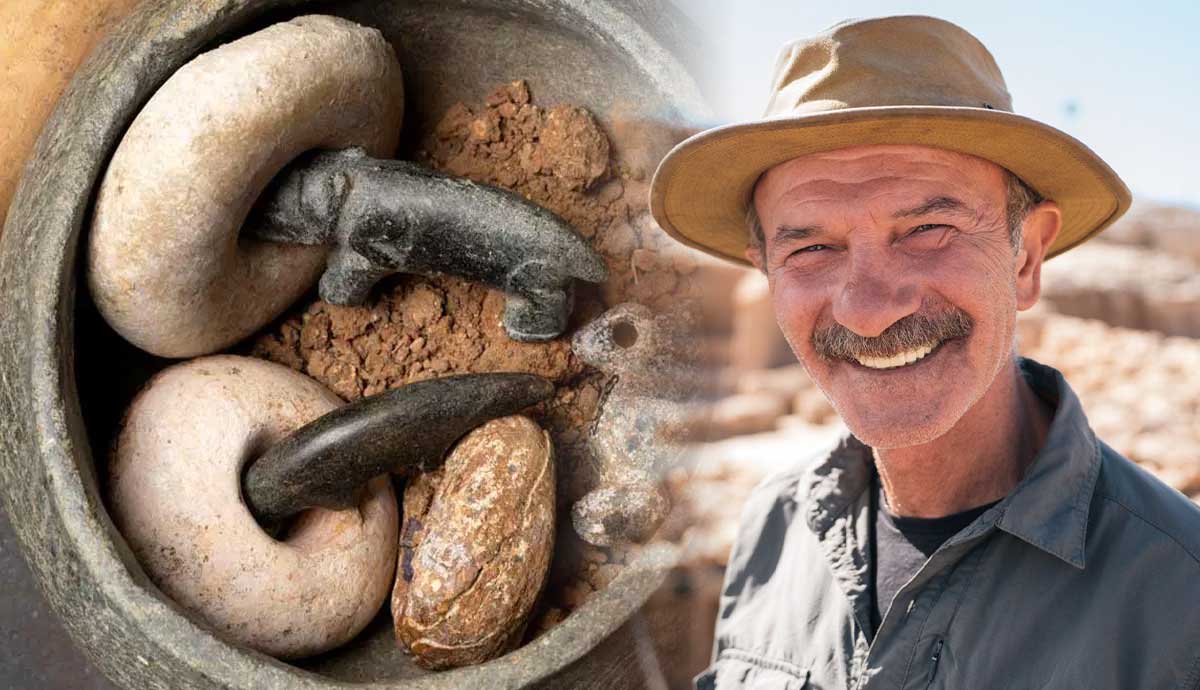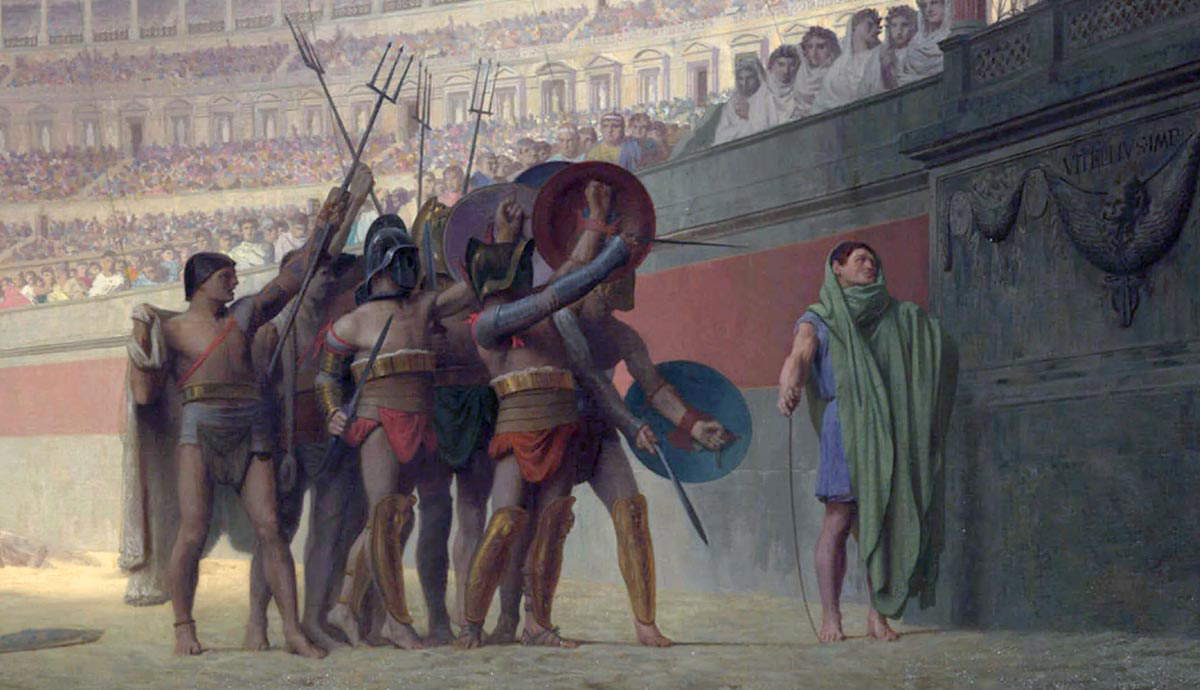
In Plato’s Meno, Socrates refers to the old Greek myth that Daedalus, the legendary inventor and sculptor, could create statues so life-like, that they were self-moving. In fact, as Socrates says, Daedalus’ sculptures had to be tied down, because if left unbound, they ran away.
Socrates: That if they [the images of Daedalus] are not fastened up they play truant and run away; but, if fastened, they stay where they are.”
Plato, Meno 97d
Of course, Socrates (and Plato) was not naïve. He understood that this story was just… a story. However, for the sake of argument, he pretended to believe in it. Just like Socrates, let’s also pretend to believe in the wonders performed by Daedalus. Let’s pretend that he actually created animate statues and built a labyrinth with a minotaur in its center. Let’s also pretend that the myth of Daedalus and Icarus, the father and son, who flew using wings made of feathers and wax is true. Unlike Socrates, we will not believe in these stories to support an argument, but simply because sometimes that is the best way to get the best out of a myth.
Daedalus and a Story of Bestiality

“Pasiphae joyed in adultery with the bull.”
Ovid, Ars Armatoria I.IX
Pasiphae was the wife of Minos, the legendary king of Crete. She was the protagonist in one of the most shocking stories from Greek Mythology, a story of bestiality.
The story goes that when Minos was establishing his kingship over Crete, he boasted that the gods favored him. To prove it, he prayed to Poseidon for a bull to appear from the sea, promising to return the animal as a sacrifice. Minos’ wish came true. A bull of incomparable beauty made his appearance, but now Minos had second thoughts. The bull was too beautiful, too strong to be sacrificed. So in his place, Minos offered another bull and kept the one sent by the god. Poseidon was furious. This was an act of defiance that could not go unpunished. Minos had to pay and the god of the ocean threw a truly terrible curse to the Cretan’s house.
Poseidon cursed the bull to go wild and Pasiphae to fall in love with the animal that Minos had liked so much. Pasiphae went mad with lust. The burden of this divine madness was unbearable. The only way to get rid of it was to satisfy the unstoppable urge to mate with the bull. But this was a trickier problem than it sounds. The bull would just not mate with Pasiphae, so the woman asked for the help of Daedalus, who was living in Minos’ palace at the time.
Daedalus conceived a plan that was at the same time ingenious and disturbing. I will leave its description to Apollodorus (Library 3.1.4):
He [Daedalus] constructed a wooden cow on wheels, took it, hollowed it out in the inside, sewed it up in the hide of a cow which he had skinned, and set it in the meadow in which the bull used to graze. Then he introduced Pasiphae into it; and the bull came and coupled with it, as if it were a real cow.

Daedalus became the genius behind one of Greek Mythology’s greatest monstrosities. From the unnatural union of Pasiphae and the bull of Poseidon, the Minotaur was born, a terrible creature who had the head of a bull and the body of a human. Moreover, the Minotaur was a powerful beast who feasted on human flesh. But even worse than that, he was a living reminder of Minos’ defiance of the gods and Pasiphae’s great sin.
Architect of the Labyrinth

To confine the Minotaur, Minos asked Daedalus to construct the Labyrinth near his palace in Knossos. Daedalus accepted the challenge and proved once again that his skill was unsurpassable. He built a gigantic labyrinth which was a maze with only one entrance. Daedalus’ Labyrinth was designed so that it was impossible to find its only exit once inside. According to Ovid (VIII.183-235), the Labyrinth was so well-built that even Daedalus himself barely managed to find the exit once inside. In the center of this architectural wonder stood the Minotaur, ready to devour those lost inside the Labyrinth.
According to the myth, Minos used the Labyrinth to reign over the city of Athens using fear. He ordered that seven young women and seven young men from Athens be sent as tribute every 7-9 years. The Athenian tribute would then be thrown into the Labyrinth to be consumed by the Minotaur. Theseus put an end to this, but that is another story.
Daedalus the Murderer

But why was Daedalus doing in Minos’ palace in the first place? According to some sources, Daedalus was from Athens, while according to others, he was a native of Crete. No matter his nationality, at some time in his life, he found himself in Athens.
At that time, his ingenuity was recognized and Daedalus enjoyed the esteem of the Athenians. That was until his sister send her son named Talos (or, depending on the source, Calos or Perdix) to study next to Daedalus. Talos was still very young and ready to absorb knowledge, and so he did. Soon, the child had shown clear signs that he was a mastermind. Ovid (Metamorphoses VIII.236-259) narrates that Talos observed a fish’s skeleton and used iron to mimic it, thus inventing the saw. Then he observed a snake’s teeth and invented a tool used to make circles modeled after the serpent’s teeth.
Daedalus was a good teacher but only up to the point that he was sure that his authority was not being challenged. Seeing that Talos was on the path of becoming his equal or even his superior in technical skill and inventiveness, Daedalus felt threatened. Jealousy blurred his mind and unable to resist his worst tendencies, Daedalus threw Talos off the sacred hill of the Acropolis. In Ovid’s version, Athena saved Talos by turning him into a partridge.
The Athenians took Daedalus to the high court of Areopagus, where the jealous inventor was found guilty and banished from the city. Then, for better or worse, he found refuge in the court of Minos.
Daedalus and Icarus

Even though Daedalus was welcomed in the palace of Minos, he helped his benefactor’s wife cheat on her husband with a bull leading to the birth of the Minotaur. To make matters worse, he also helped the Athenian hero Theseus escape the Labyrinth by offering a thread to Minos’ daughter Ariadne who was in love with Theseus. The slew helped Ariadne track her way through the Labyrinth and successfully extract her beloved who slew the Minotaur.
Minos was furious and imprisoned the inventor in a cell with Icarus, his son from a slave called Naucrate. Depending on the source, Daedalus was imprisoned for his involvement in Pasiphae’s sin or for offering help to Minos’ enemy, Theseus. In the end, however, the reason for Daedalus and Icarus’ imprisonment is not that important. No matter what, I think we can all agree that Daedalus had done quite a few things to anger Minos.
Daedalus and Icarus spent their days in the cell, which seems to have been positioned on top of a tower. The growing fear over their lives was getting more and more difficult to bear until one day Daedalus proclaimed:
“He may thwart our escape by land or sea’ he said ‘but the sky is surely open to us: we will go that way: Minos rules everything but he does not rule the heavens’.”
Ovid, Metamorphoses VIII.183-235
Then Daedalus proceeded to construct a mythical device that people had been dreaming about for centuries until the Wright brothers proved that humanity was ready to conquer the only realm that Minos had not managed to rule, the heavens.
Daedalus observed the birds who visited his cell and carefully studied their wings. He then laid down multiple feathers in a row from shortest to longest and tied them together using bee’s wax and thread. Daedalus had just created wings and was ready to leave the cruelties of Crete behind him once and for all.

Icarus saw the invention but showed little evidence of understanding the dangers that it entailed. Ovid wonderfully describes the father’s anguish, who understands that his child is about to embark on a journey that may bring his end. With tears in his eyes and trembling hands, Daedalus begs Icarus not to take things lightly and gives him the following instructions:
“Let me warn you, Icarus, to take the middle way, in case the moisture weighs down your wings, if you fly too low, or if you go too high, the sun scorches them. Travel between the extremes.”
Metamorphoses VIII.183-235
Daedalus and Icarus wore the wings and began flying. Crete was now behind them. However, Icarus did not heed to his father’s advice. The boy became too arrogant and began flying towards the heavens wanting to reach as close to the sun as he could. The wax that brought the wings together began melting and before he had a chance to do anything, Daedalus stood powerless in front of the spectacle of his son falling from the sky crying out his father’s name. The sea where Icarus died was named Icarian sea after him and the island where Daedalus buried him, Icaria.
Minos Searches for Daedalus

Now Minos, it is said, went to Sicania, which is now called Sicily, in search for Daedalus, and perished there by a violent death. Herodotus, Histories VII.170
The tale of Daedalus does not stop at the burial of Icarus. The inventor was finally free from Minos, though at a great cost. Nevertheless, he had now found refuge at the court of the Sicilian King Cocalus.
According to Diodorus Siculus (Library of History 4.78), Daedalus constructed multiple wonders during his stay in Sicily and even built a city so ingeniously designed that it was impregnable to attack. Cocalus moved his capital there.
After discovering that Daedalus was in Cocalus’ court, Minos prepared for war. After all, he wanted his best inventor back. Cocalus called Minos to a conference and promised to accept all his demands, even to return Daedalus. However, Cocalus was more cunning than it seemed. He tricked Minos and trapped him inside the bath where the increasingly hot water killed him.
Daedalus and the Animate Statues

The Greeks believed that Daedalus was the creator of the archaic xoana. These were wooden cult statues inside temples.
Pausanias, 2nd century CE travel writer, recorded many of the xoana that were said to be made by Daedalus. It goes without saying that the archaic simplistic images depicted on wood could not compete with the art that was available to Pausanias elsewhere.
Furthermore, the marble sculptures of the Hellenistic Period could capture nature much more loyally than the naïve images of Daedalus, which due to their medium, were also deteriorating. Nevertheless, Pausanias says the following:
“All the works of this artist, although rather uncouth to look at, are nevertheless distinguished by a kind of inspiration.”
Description of Greece 2.4.5
This translation does not capture the spirit of Pausanias’ words. In the original Greek, Pausanias used the word ‘entheos’ to describe the works of Daedalus. This word can roughly translate as ‘containing the god’. This means that people saw something different in these sculptures. Their primitive nature managed to capture the divine in a way that other sculptures couldn’t.
Aside from the xoana, the Greeks attributed a series of other sculptures and objects to Daedalus as well as a series of other inventions. Pliny (Natural History 7.198) amongst others mentions carpentry, the saw, the axe, and more. There is also the legend mentioned by Plato, in the beginning of this article, according to which Daedalus was such a skilled sculptor that his creations were animate.
Palaiphatus, an ancient author who rationalized myths, believed that Daedalus did not breathe life in his statues. Instead, he invented a new convention that made them more life-like. He says that before Daedalus, the sculptors made statues with their feet joined, but Daedalus began making them with one foot forward which gave a false sense of movement.
Was Daedalus a real figure, perhaps a talented sculptor? Real or not, Daedalus’ legend (his name means skillful worker) stretches at least back to Homer and the Archaic Period.









